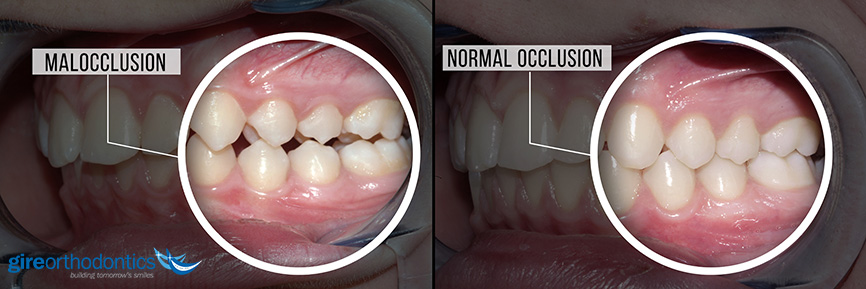
“It’s a big word, but simply means, ‘bad bite,’” says La Habra/Chino Hills orthodontist Dr. Robert Gire of Gire Orthodontics. “In an orthodontist’s office, you may hear different classifications for malocclusions – that’s our way of describing the different types of bites we see.”
So, what are the different types of malocclusions an orthodontist may correct?
Class I malocclusion
This type of malocclusion refers to a bite that may have the proper positioning, but other problems may be present. A patient may have crowding, misalignment, or rotated teeth. The upper and lower molars may be properly positioned, but there may be a cross-bite, overlapping teeth, or other issues.
Class II malocclusion
This type of bite refers to when the upper teeth are too far forward over the bottom teeth. Most people call this an overbite but that terminology is actually incorrect. When the upper front teeth protrude too far beyond the lower front teeth, that actually refers to excess over-jet (see below). The term over-bite refers to a deep bite and that can actually be seen in Class I, II, or III malocclusions.
Class III malocclusion
This refers to underbites, or when the bottom teeth are too far forward of the upper teeth.
Understanding the type of malocclusion you have can better help you understand the treatment plan your orthodontist creates for you. In addition to these classifications, there are common malocclusions that an orthodontist treats.
An over-jet, or upper protrusion, occurs when the upper front teeth are pushed too far out. We often use the slang term “buck teeth” to refer to this type of malocclusion. We see this often in patients who have a lower jaw that is too small, and in patients who used a pacifier or sucked their thumb for an extended period.
When a patient has too much room in their mouth, we see spacing issues where the teeth are too far apart. Likewise, if there is too little room in the mouth, the patient will have crowding issues where the teeth are overlapped.
A patient with an open bite will have upper and lower front teeth that do not overlap when the molars fit together. There will be a small opening straight into the mouth.
Overbites occur when the upper front teeth reach too far down over the lower teeth. In a severe overbite, the lower teeth will bite into the upper palate. On the reverse side, an underbite is present when the lower bottom teeth are too far forward and come over the upper front teeth.
A patient with a crossbite will have their upper teeth fit on the wrong side of the lower teeth. Rotation refers to a tooth that is turned or otherwise out of its normal position. A transposition happens when a tooth erupts in the wrong location.
“In a properly aligned mouth, the upper front teeth will be slightly forward of the lower front teeth, and the back molars will fit properly together,” says Dr. Gire. “An orthodontist’s job is to identify which, if any, malocclusion is present and develop the proper treatment plan to correct it, if treatment is indicated.”
Every patient is different, and every malocclusion is different. Two patients may present with seemingly similar issues, but their treatment will be unique because they are unique. Dr. Gire carefully crafts custom treatment plans for each of his patients that take into account not only their malocclusion, but also their age, health, esthetic goals and even their family history.
If you have questions about malocclusions, or have concerns about your smile, call Dr. Gire for a consultation today at 562-690-1199 (La Habra) or 909-393-9911.

